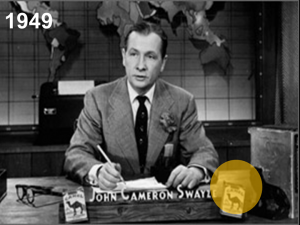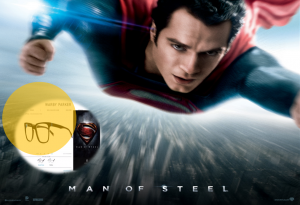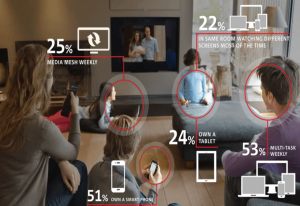 Product placement has been around as long as TV itself. One of the earliest examples of product placement was in 1949 when NBC launched America’s first daily TV news programme, the ‘Camel News Caravan’, featuring a newsreader smoking a Camel cigarette and a policy that banned footage of ‘no smoking’ signs and anyone puffing on a cigars, including Sir Winston Churchill!
Product placement has been around as long as TV itself. One of the earliest examples of product placement was in 1949 when NBC launched America’s first daily TV news programme, the ‘Camel News Caravan’, featuring a newsreader smoking a Camel cigarette and a policy that banned footage of ‘no smoking’ signs and anyone puffing on a cigars, including Sir Winston Churchill!
Today, brand and product tie-ins are less brazen but equally effective as a weapon for achieving a brand positioning advantage over the competitors’ above-the-line PR and marketing efforts.
The James Bond film franchise is credited with having started the current fashion of placing well-known branded products in the centre of the action, with brands such as Aston Martin and Omega taking high profile roles on screen.
 In the Bond movie ‘Skyfall’ actor Daniel Craig is seen drinking a Heineken beer. Typically, this type of product placement is supported by heavy above-the-line advertising spend as well as online and social media interaction with fans so as to create the cut-through required.
In the Bond movie ‘Skyfall’ actor Daniel Craig is seen drinking a Heineken beer. Typically, this type of product placement is supported by heavy above-the-line advertising spend as well as online and social media interaction with fans so as to create the cut-through required.
The Great Gatsby, starring Leonard DiCaprio follows a long tradition of movies from the US being ‘sponsored’ by brands and took this to another level.
Some critics have panned the movie as ‘disappointing’ but the same can’t be said of the starring roles played by Moet & Chandon (champagne), Brooks Brothers (suits), Prada (cocktail dresses), Fogal of Switzerland (hosiery) and Tiffany & Co (jewellery) that steal the show.
There’s no doubt film makers love product placement as it can account for a major slice of the profits generated by a movie.
 For example, product placement deals for the latest Superman movie Man of Steel generated a whopping 75% of the total production budget, a cool $160m.
For example, product placement deals for the latest Superman movie Man of Steel generated a whopping 75% of the total production budget, a cool $160m.
The movie features over 100 promotional tie-ins with a range of brands that perhaps you wouldn’t have expected to see on the big screen such as Sears, IHOP and 7/11.
These brands were interwoven into the fabric of the story in a subtle way where they didn’t stick out like a sore thumb.
Even a relatively unknown brand Warby Parker created the iconic black eye wear glasses for Superman and this has spawned an exclusive new range of eye wear on its e-commerce site, inspired by the movie.
However, not everyone is happy about the increasing use of product placement in this way. Critics of product placement are plentiful and various and include consumer groups frightened that editorial and creative independence has been sold to the highest bidder and church groups that worry the corrosive effect of commercialisation of TV content is projected to millions of viewers in their living rooms.
Even the esteemed Writers Guild of America, the union representing TV scriptwriters, has jumped on product placement practices, alleging that its members are being forced to write advertising copy disguised as storylines and that ‘tens of millions of viewers are sometimes being sold products without their knowledge, in opaque, subliminal ways’.
 Public Citizen’s Commercial Alert, a US campaign group, has labelled product placement an ‘affront to basic honesty’ but this hasn’t dented the enthusiasm among successful British TV producers like Peter Bazalgette of ‘Big Brother’ fame from launching his own embedded advertising company last year and who confidently predicts the UK market could be worth in excess of £100m a year in revenues.
Public Citizen’s Commercial Alert, a US campaign group, has labelled product placement an ‘affront to basic honesty’ but this hasn’t dented the enthusiasm among successful British TV producers like Peter Bazalgette of ‘Big Brother’ fame from launching his own embedded advertising company last year and who confidently predicts the UK market could be worth in excess of £100m a year in revenues.
In the UK, product placement has been on our screens for some years, appearing within acquired programming from overseas or as legitimate prop provision – a natural part of making TV programmes.
Since February 2011, certain programmes have also been able to contain paid for product placement as long as they comply with Ofcom’s rules and advertisers have taken advantage of this opportunity to get their brands woven into the editorial of TV shows in order to get closer to their viewers and some gratifying results have been achieved.
The sectors most active in this area of brand communication include drinks and beverages, cars, food and perishables, media and entertainment, household and personal goods, toiletries and cosmetics as well as pharmaceuticals and financial services and budgets for product placement can range anywhere from £100,000 to over £5m.
Summary of the product placement rules in the UK
- The product placement rules apply to all programmes broadcast on channels licensed by Ofcom.
- Product placement is allowed in films (including dramas and documentaries), TV series (including soaps), and entertainment shows and sports programmes.
- Products cannot be placed in news or children’s programmes. They also cannot be placed in religious, current affairs and consumer advice programmes made for UK audiences
- Cigarettes and other tobacco products, along with medicines that are available only on prescription, can’t be product placed in any programmes.
- Alcoholic drinks, gambling products, all other types of medicines, baby milk, food and drink that’s high in fat, salt, or sugar can’t be product placed in UK programmes.
- Products that can’t be advertised (such as guns and other weapons) can’t be product placed in UK programmes either.
- There must be ‘editorial justification’ for a product to be placed in a programme. That means the product must have a natural fit with the storyline.
- The content of programmes shouldn’t seem to be created or distorted, just to feature the placed products.
- Programmes also can’t promote placed products or give them too much prominence. So there shouldn’t be any claims made about how good a placed product is, or so many references to a product that it feels like it is being promoted.
- The Product Placement (PP) logo must be shown for three seconds at the beginning and end of the programme and also shown briefly in the ad break during the programme.
Mark Popkiewicz, CEO of MerriAd claims his agency has created technology that allows brands to be immersed into live action in such a way so that the audience feels it’s a natural part of the scene. “When a consumer watches a show they are not ‘defensive’ against advertising as they might be with advertising online or commercials on TV. Instead, they are in receive mode and are not blocking,” he says.
 These so-called ‘integrations’ have crossed over into the world of media buying and such opportunities now have a powerful analytical engine that can calculate the value of exposure in a much more precise way even before the content has been made. “The net effect is an increase in brand awareness, an increase in the intent to purchase and an increase in product sentiment where the brand needs to be in the right place at the right time,” explains Mark Popkiewicz.
These so-called ‘integrations’ have crossed over into the world of media buying and such opportunities now have a powerful analytical engine that can calculate the value of exposure in a much more precise way even before the content has been made. “The net effect is an increase in brand awareness, an increase in the intent to purchase and an increase in product sentiment where the brand needs to be in the right place at the right time,” explains Mark Popkiewicz.
Nor is this development restricted to static objects as the technology is capable of placing or replacing moving objects and even replacing products being handled by actors in a movie, like a mobile phone. It’s fast becoming possible where products can be tailored to meet individual consumer preferences for certain brands like a piece of direct mail. With dual screening now the norm, brand owners must now explore more sophisticated ways in which to engage their audiences outside of a traditional linear broadcast.














Recent Comments